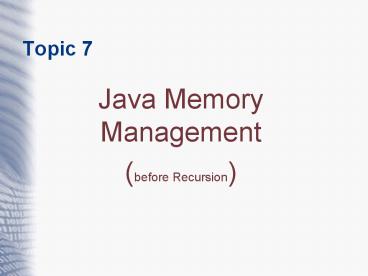Java Memory Management - PowerPoint PPT Presentation
1 / 15
Title:
Java Memory Management
Description:
When a program is executed, its memory area typically consists of: the code segment: a storage area for a program or the part of the program that is executing ... – PowerPoint PPT presentation
Number of Views:133
Avg rating:3.0/5.0
Title: Java Memory Management
1
Topic 7
- Java Memory Management
- (before Recursion)
2
Chapter Objectives
3
Memory Allocation in General
- When a program is executed, its memory area
typically consists of - the code segment a storage area for a program or
the part of the program that is executing - the runtime stack used when calling methods, to
hold local variables, parameters, returned
values, etc. - the heap used to hold dynamic data (e.g. objects)
4
Memory Allocation in Java
- separate areas of memory are allocated for each
class, interface, object, and running method - runtime stack used for method information
- heap used for static information (interfaces and
classes) and instance information (objects) - example what happens when an object is created
by new? - a reference variable is put on the runtime stack
- an object is created using memory in the heap
5
Runtime Stack
- runtime stack is the memory space used when a
method is executed - keeps track of method invocations, holds local
variables, parameters, etc. - runtime stack is also called program stack or
system stack - when a method is invoked, an activation record
that represents the invocation is pushed onto the
runtime stack
6
Activation Record
- an activation record ( or call frame ) contains
- address to return to after method ends
- copy of the methods local variables
- copy of the methods parameters for that
invocation
7
Example
- when the main method is invoked, an activation
record for main is created and pushed onto the
runtime stack - (diagram)
8
Example (contd)
- suppose main calls the method m2
- an activation record for m2 is created and pushed
onto the runtime stack - suppose m2 calls m3
- an activation record for m2 is created and pushed
onto the runtime stack - when m3 terminates, its activation record is
popped off and control returns to m2 - when m2 terminates, its activation record is
popped off and control returns to main - when main terminates, its activation record is
popped off and control returns to the operating
system
9
Heap
- static space contains one copy of each class and
interface named in the program - contains their static variables and methods
- object space
- information is stored about each object
- value of its instance variables
- type of object (i.e. name of class)
- memory address of object (unique)
10
Object Creation
- memory is allocated in the heap area when an
object is created using new - the reference variable is put in the call frame
on the runtime stack - an object is created using memory in the heap
11
Memory Deallocation
- what happens when a method returns?
- on the runtime stack, the call frame is
automatically popped when the method returns - so, that memory is deallocated
12
Garbage Collection
- what happens to objects on the heap?
- an object stays on the heap even if there is no
longer a variable referencing it - so, Java has automatic garbage collection it
regularly identifies objects which no longer have
a variable referencing them, and deallocates the
memory
13
Parameter Passing in Java
- pass by value used with simple variables
(integers, doubles, etc.) - a copy of the contents of the actual parameter is
used by the method - the method can change the copy
- can it change the original?
14
Parameter Passing (contd)
- pass by reference used with reference variables
- a copy of the contents of the actual parameter is
used by the method - but, what is that? a reference to the object
- so, the method can change the object, since it
knows where it is - note that in fact, the reference is being passed
by value
15
Examples































